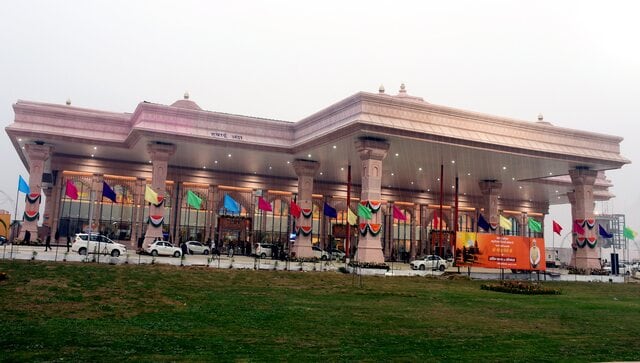Uttar Pradesh’s Ayodhya is geared up for the consecration ceremony of Ram Mandir on 22 January. Amid the opening of the grand temple and the expected tourism boom, the city, situated on the banks of river Saryu, is undergoing a massive facelift.
Ayodhya is not also being developed as a spiritual hub but as a major economic centre. The holy town is bustling with decorated buildings, widened roads, luxury hotels, an international airport, and much more.
With just a week to go for the inauguration of the Ram temple, let’s chart the course of how Ayodhya is transforming.
Luxury hotels and more
The temple town, which is being refurbished as a smart city, is on the path of development with hundreds of new projects underway.
Hoteliers are flocking to the town, with the Ayodhya Development Authority (ADA) already having cleared applications for 35 new hotels, both big and small, as per an Indian Express report.
Ayodhya will witness India’s first seven-star luxury hotel serving only vegetarian food, reported NDTV. As many as 110 small and big hoteliers have shown interest in the city.
Mumbai-based realty developer The House of Abhinandan Lodha (HoABL) reportedly plans to invest over Rs 2,000 crores to build five luxury hotels across UP’s Ayodhya, Varanasi and Vrindavan, Shimla in Himachal Pradesh, and Punjab’s Amritsar. Reports estimate the real estate firm could cough up Rs 14.5 crore for a 10,000 sqft land to set up a five-star hotel in Ayodhya.
At least eight townships have already been sanctioned in the temple town, with the largest private one being built over 59,000 square metre, reported Times of India (TOI).
Ayodhya is also set to get 600 homestays. Vishal Singh, Vice Chairman of the ADA, told Indian Express that 600 applications for homestays have been approved so far.
A solar park is also in the pipeline. A chopper service from Lucknow is expected to start on Friday.
From revamp of infrastructure to beautification drive, the ADA is monitoring 178 projects worth Rs 29,604 crore, reported Indian Express.
Expanding roads
The four narrow and cramped roads around the temple complex have been expanded and beautified and given new names – Ram Path, Dharma Path, Sri Ram Janma Bhumi Path and Bhakti Path.
Ram Path, which connects Sadatganj to Lata Mangeshkar Chowk at Naya Ghat, has been widened to a 13-km-long, four-lane road, reported Indian Express.
Ayodhya’s district magistrate (DM), Nitish Kumar, told News18 last November that over 800 establishments were removed on either side of Ram Path to expand the road.
Ram Path is illuminated by Surya Stambhs or lamp posts lining both sides of the footpath. The boulevard, built at an estimated investment of Rs 798 crore, boasts big showrooms of multinational brands, according to Moneycontrol.
On the Ram Path, the ADA has painted shutters of shops with Hindu symbols – the shankh, trishul, gada and swastik, reported Indian Express.
“Ram Path has now become the lifeline of Ayodhya. It connects Ayodhya (earlier Faizabad) with Ayodhya Dham. Now, the city’s life revolves around this 13-km stretch of the road,” Raju Das, the priest of Hanuman Garhi temple, told Moneycontrol.
As per Indian Express, the 566-meter-long Sri Ram Janmabhoomi Path leading to the Ram temple from Sugreev Kila was built with an investment of Rs 41 crore.
The 2-km-long Dharma Path is a four-lane road connecting Lata Mangeshkar Chowk to the Lucknow-Gorakhpur highway. Speaking to Moneycontrol, Sanjeev Maurya, owner of a tea shop on Dharam Path, said confidently, “This Path is our Connaught Place, and in no time, it will be the centre of attraction in Ayodhya.”
Developed for Rs 65 crore, dark grey pillars carved with ‘Sri Ram’ and adorned with Sun-shaped lights line both sides of Dharma Path, reported Indian Express.
The 742-metre-long Bhakti Path linking Sringhar Ghat to Hanuman Garhi has been constructed at a reported cost of Rs 68 crore.
According to Moneycontrol, several temples are being renovated across the city to encourage tourists to extend their stay to explore the rich heritage of Ayodhya.
New airport, revamped railways
Ayodhya has a state-of-the-art international airport. Prime Minister Narendra Modi inaugurated ‘Maharishi Valmiki International Airport Ayodhyadham’ last month.
The airport costing over Rs 1,450 crore has a facade built in the ‘nagara’ style of North Indian temple architecture. The structure has seven mounted peaks or shikharas at the front and back sides. Several murals showcasing various stages from the epic Ramayana adorn the airport, with one of the biggest dedicated to Lord Hanuman.
The terminal building can accommodate 600 passengers at peak time, while its annual handling capacity is 10 lakh passengers. The second phase of the airport will include the development of a new terminal building spread across 50,000 square metres.
The redeveloped Ayodhya Dham railway station has a three-storey building equipped with escalators, lifts, waiting halls, toilets, drinking water stations, a food plaza and the “largest concourse in the country”, reported Indian Express.
Built for Rs 251 crore, the revamped station, about 6km away from the Ram temple, is capable of handling 40 trains a day and over 50,000 passengers.
Economic boom
Ayodhya is expecting a footfall of more than a lakh pilgrims a day once the gates of Ram temple are opened to the public from 24 January.
“Ayodhya holds immense potential as a spiritual destination for tourism, especially with the upcoming opening of the Ram temple. We believe the tourism industry could see a 10-fold increase by 2024, making Ayodhya a global spiritual centre,” Kamlesh Singh, a tour operator in Lucknow, told Moneycontrol.
The UP government is aiming to develop Ayodhya as a major destination for spiritual tourism globally.
“Following the consecration of Shri Ram Lalla on 22 January, Ayodhya is set to emerge as a highly developed and prominent tourist destination on the global tourism map. The double-engine government is actively working on the development of religious tourist sites across the state,” UP chief minister Yogi Adityanath was quoted as saying by Moneycontrol. “Ayodhya’s increasing prominence is not just limited to its spiritual and emotional significance; it is emerging as a major tourist destination. The city has recently been granted international airport status to facilitate global connectivity.”
The temple town could see a business boom of Rs 50,000 crore once the temple opens, Moneycontrol reported citing experts.
According to the Confederation of All India Traders (CAIT), the consecration ceremony is projected to generate business worth Rs 1 lakh crore. “This event not only resonates with religious sentiments but also brings a surge in economic activities. The faith and trust of people are leading to the creation of many new businesses based on the country’s traditional economic system,” Praveen Khandelwal, National Secretary General of CAIT, said, as per the news agency PTI.
As Yatindra Mishra, poet and descendant of the erstwhile royal family of Ayodhya, told Indian Express, “Until recently, the economy of this town revolved around three annual religious melas — Ram Navmi in April, Savan in July-August and Kartik Poornima in November. Now with the temple, there will be more people coming to Ayodhya than ever before.”
With inputs from agencies
Link to article –
Luxury hotels, revamped roads… How Ram Mandir event is transforming Ayodhya





